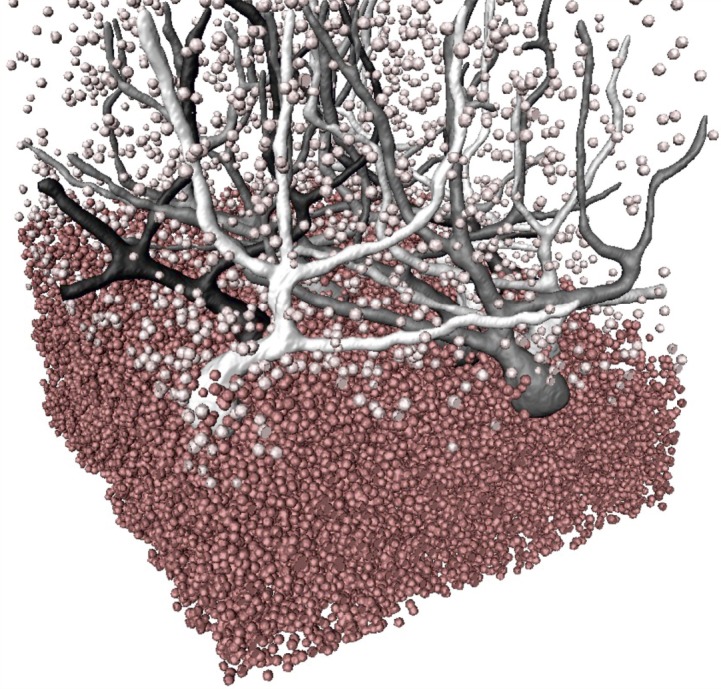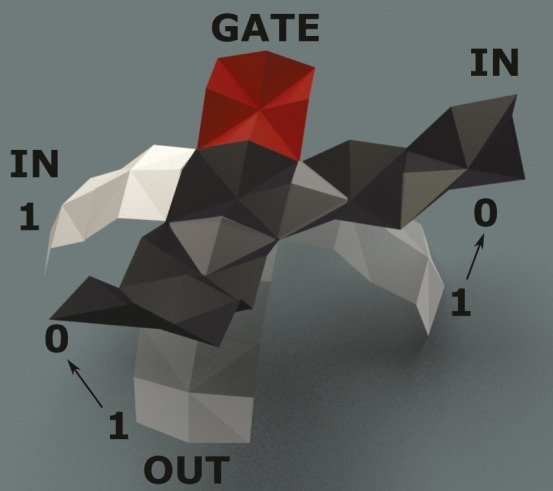Optimized tomography offers path to 3D virtual histology of brain tissue

Cell segmentation in the granular layer (dark red), the molecular layer (light red), and the Purkinje cell layer (gray).
When stained and examined under a light microscope, micrometer-thick slices of brain tissue can help uncover relationships between cellular architecture and function in the human brain. Although histology is commonly used to analyze brain tissue at nonisotropic scales, the technique is destructive and labor-intensive. Mareike Töpperwien et al. (pp. 6940–6945) demonstrate that propagation-based X-ray phase-contrast tomography can enable noninvasive 3D virtual histology on unstained, paraffin-embedded human brain tissue. Using customized optics, data reconstruction algorithms, and image analysis, the authors acquired data of sufficient resolution to image and automatically identify as many as 1 million neurons across multiple tissue layers. Furthermore, the technique produces 3D digitized density maps at subcellular resolutions that can be virtually sliced in all possible orientations. As a proof of concept, the authors applied the technique to human cerebellum and present a quantitative analysis revealing how the cerebellum houses 80% of the brain’s neurons in 10% of its volume. The ability to automate and digitally analyze 3D cellular distributions at nonisotropic scales could also help link specific changes in cellular architecture with the onset of neurodegenerative disorders, according to the authors. — T.J.
How Zika virus infects the fetal brain
Zika virus is a mosquito-borne flavivirus that has recently spread throughout the Americas and the Caribbean, causing severe birth defects such as microcephaly—a condition in which an infant’s head is smaller than expected. How Zika virus reaches the fetal brain and which cell types may act as viral reservoirs remain unclear. Nor is it clear why the closely related dengue virus does not cause fetal brain injury. Julien Muffat et al. (pp. 7117–7122) compared the effects of dengue and Zika infection on various types of brain cells, including immune cells called microglia, which were generated from induced pluripotent stem (iPS) cells derived from a human donor. Exposure of iPS-derived microglia-like cells to the dengue virus triggered the production of immune molecules called cytokines and chemokines, resulting in cell death within 3 days of infection. By contrast, Zika-infected microglia-like cells survived, released viral RNA within 10 days of infection, and were capable of spreading the virus to neural progenitors. Exposure to Zika virus, but not dengue virus, caused iPS-derived neural progenitors to die due to ineffective antiviral responses. The findings suggest that circulating early macrophages—microglial precursors that originate close to the maternal vasculature—may act as a reservoir for Zika virus, carry the virus to the fetal brain, and mediate infection of highly vulnerable neural progenitors. — J.W.
Buried junction stabilizes photoelectrochemical water oxidation
Water-splitting dye-sensitized photoelectrochemical cells (WS-DSPECs) mimic natural photosynthesis by using light-harvesting dye molecules coupled with water-oxidation catalysts to enable light-driven water oxidation. Although WS-DSPECs represent a promising strategy for artificial photosynthesis, such systems currently lack stability because their components break down under the strongly positive electrode potentials associated with anodic reactions. Pengtao Xu et al. (pp. 6946–6951) present a solid-state dye-sensitized solar cell design that performs stably under water-splitting conditions. Acting as a buried junction, the device uses a solid-state hole conductor to separate the dye and water-oxidation catalyst within a 2-nm-thick coating of titanium oxide, grown by a process called atomic layer deposition. Although the coating reduces performance due to increased resistance, isolating the molecular components from the water-splitting solution results in a system that can use efficient light-absorbing dyes and optimize pH for catalytic water oxidation. The findings demonstrate that the solar cells can serve as buried junctions in WS-DSPECs to enhance stability and help create artificial photosynthetic systems that convert sunlight into chemical fuels, according to the authors. — T.J.
Alcohol and fertility in hunter-gatherers

Traditional pygmy Baka hut.
Humans are a polymorphic species with high diversity in growth and development. Life-history studies of hunter-gatherer societies can offer insight into growth and development differences across populations. Fernando Ramirez Rozzi (pp. E6126–E6134) describes a link between alcohol and fertility in the Baka pygmy people of Cameroon, a hunter-gatherer society that exhibits a small body size related to low growth during infancy, but experiences sexual maturity and first delivery at an age similar to individuals of other human populations. The study focused on the Baka population of Le Bosquet district in Cameroon, where birth records have been kept since 1980. In addition to birth records, the study examined chronological records of individuals and field data on fertility and mortality collected from 2007 to 2017. The study revealed that the Baka exhibit low infant and juvenile mortality, slow growth, and high fertility at an early age. However, the study notes a significant decrease in the fertility rate since 2011. The fertility decrease is most pronounced in the lower age classes of the Baka and corresponds with the arrival of cheap alcohol in the community, an observation supported by anecdotal evidence from Baka women. The work highlights links between alcohol and the fertility and survival of a hunter-gatherer society, according to the author. — C.S.
Mechanical logic for soft robots

Autonomously reconfiguring origami units can form dynamic Boolean logic gates.
Robots are characterized by their ability to make decisions based on environmental stimuli. Such decisions are typically made in a central processing unit (CPU) using conventional digital logic. However, robots with a soft or flexible structure are constrained by the rigid nature of CPU electronics. Benjamin Treml et al. (pp. 6916–6921) constructed a soft robot made of a sheet of polypropylene folded into an origami waterbomb base. Along the vertices and folds of the origami base, the authors deposited a polymer that expands or contracts depending on relative humidity. The polymer served as an actuator, changing the shape of the robot depending on the environmental humidity. Thus, the robot was able to transform humidity, an environmental signal, into a mechanical signal. Further, as the origami base has two primary shapes, the shape can serve as a binary signal. Joining several of these units enables them to share information, construct basic Boolean logic operations, and engage in locomotion. According to the authors, the logic employed by the environmentally sensitive actuators portends the development of soft robots that possess the environmental responsiveness of rigid robots without the mechanical constraints of conventional electronics. — P.G.


